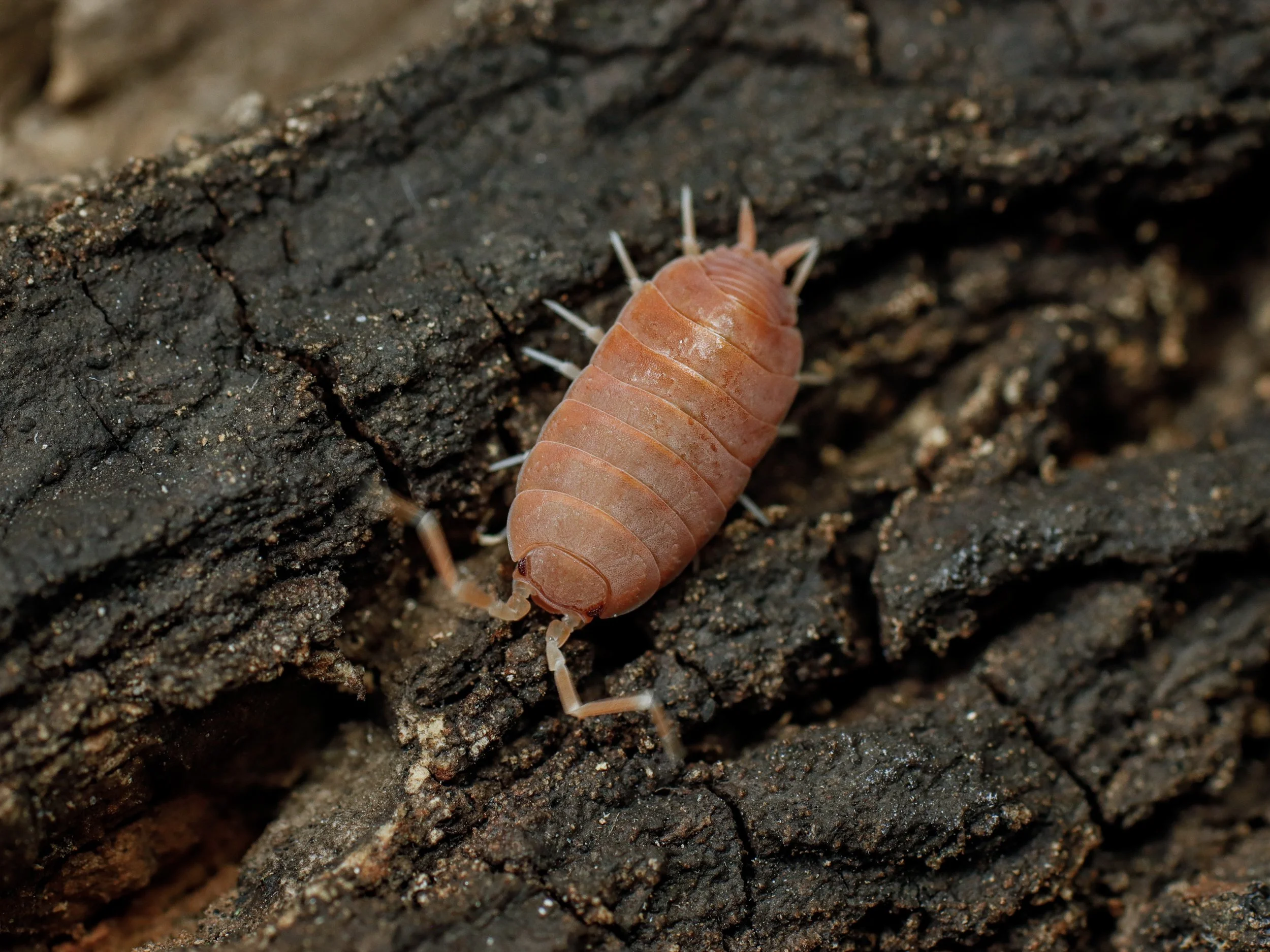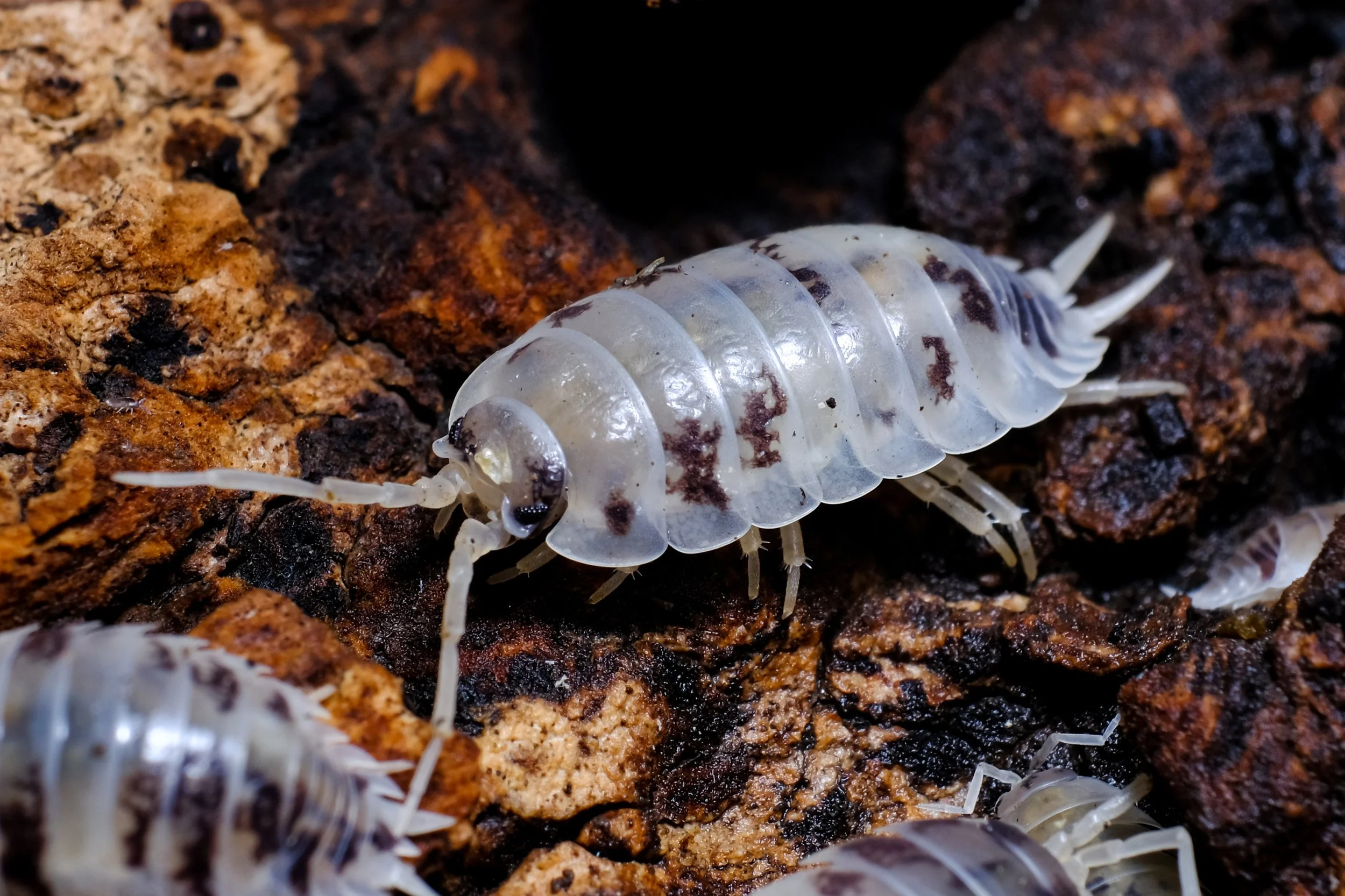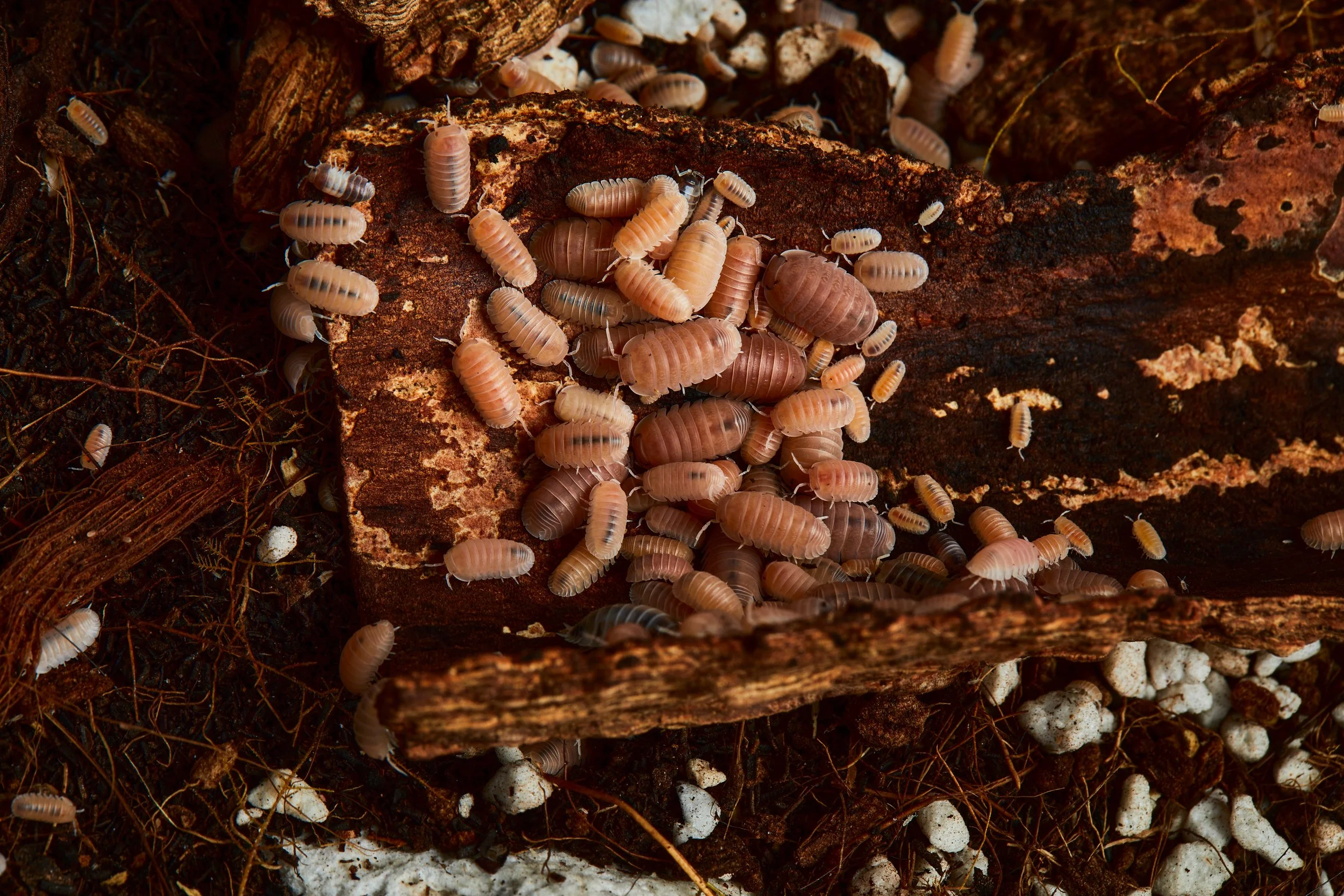Meet the Crew: Beginner Isopods for Your Bioactive Terrarium
Greetings, fellow bioactive enthusiasts! If you're new to the captivating world of bioactive terrariums and wonder which isopods to choose, you're in the right place. In this post, we'll introduce you to the perfect beginner isopods for your bioactive setup. These little creatures are nature's cleanup crew and are incredibly easy to care for, making them an ideal choice for your mini-ecosystem. Let's dive in and meet the crew that will help your bioactive terrarium thrive!
Porcellionides pruinosis - The Powders
For those taking their first steps into the world of bioactive terrariums, Porcellionides pruinosus emerges as the top choice. This diverse species encompasses the charming Powder Blue, Powder Orange, White Out, Oreo Crumble, and Orange Cream Isopods. There's even a party mix for those who can't pick just one color.
But what truly sets them apart isn't just their vibrant colors – it's their remarkable suitability for beginners. Here's why they're such an excellent pick:
Appearance: These isopods measure about 1/2 inch (1.3 cm) in length, making them easy to spot as they diligently perform their vital tasks. Their colors span the spectrum, including blue, orange, black and white (the Oreo Crumbles are a pied variety), orange and gray (the Orange Creams), and pure white.
Behavior: Porcellionides pruinosus earns its accolades for its low-maintenance disposition. These hardy isopods are incredibly adaptable, proficiently breaking down organic matter within your terrarium. They actively consume decaying leaves, wood, and detritus, leading to a cleaner, healthier environment for your plants and animals.
Breeding: These isopods are prolific breeders, which is a boon for your bioactive setup. Under the right conditions, they reproduce readily, ensuring a consistent population that aids in waste decomposition.
Humidity and Temperature: Maintaining humidity levels between 70-80% and temperatures around 70-78°F (21-26°C) suits their preferences. Remarkably, they can also thrive in arid conditions, especially when you provide a moist area near their water dish.
In summary, Porcellionides pruinosus stands as an outstanding choice for beginners, boasting captivating appearance, easy care, and top-notch waste management skills. By introducing these isopods to your bioactive terrarium, you'll elevate both its aesthetics and functionality, creating a thriving mini-ecosystem.
Porcellio laevis - Dairy Cows
Let us introduce you to Porcellio laevis, a standout among isopods. While several varieties exist, dairy cow and milk backs are often the preferred choices, especially for breeding enthusiasts. If you're new to the world of bioactive enclosures, this species is an excellent starting point, but there's an important detail to note.
Appearance: Porcellio laevis boasts a smooth, glossy texture and is notably larger than many other isopods, typically measuring around 1/2 inch (1.3 cm) in length. Dairy cows sport distinctive black and white splotches resembling their namesake, while milk backs feature a gray body with a whitish line along their backs.
Behavior: What truly sets Porcellio laevis apart is its low-maintenance nature and adaptability. These isopods are renowned for their robustness and resilience, excelling at breaking down organic matter like decaying leaves and wood. This talent ensures a cleaner and healthier environment for your terrarium's inhabitants.
Breeding: Like their isopod cousins, Porcellio laevis is a prolific breeder, making them invaluable for maintaining a consistent population within your bioactive setup. Their contribution to waste decomposition cannot be overstated.
Humidity and Temperature: To keep your Porcellio laevis thriving, maintain humidity levels between 70-80% and temperatures between 70-78°F (21-26°C). These conditions are well-suited to their preferences, making them adaptable for various types of enclosures, including arid setups.
The Caveat: Here's the important detail to remember – Porcellio laevis, particularly dairy cows, have a penchant for protein. Some reports suggest they may nibble on molting insects, soft-skinned reptiles, or amphibians, which has led to concerns about their dietary habits. While it's believed that they primarily consume decaying matter, it's essential to be aware of this behavior. To ensure their nutritional needs are met, consider supplementing their diet with protein sources within the enclosure.
In summary, Porcellio laevis is an outstanding choice for beginners due to their straightforward care requirements and exceptional waste management abilities. These Smooth Isopods, though unassuming in appearance, play a pivotal role in establishing a harmonious and flourishing bioactive terrarium.
Trichorhina tomentosa - Dwarf Whites
Let's dive into the world of Trichorhina tomentosa, affectionately known as the Dwarf White Isopod. If you're embarking on your bioactive enclosure journey, this species offers an excellent introduction, boasting its unique attributes.
Appearance: The Dwarf White Isopod may be petite in size, measuring around 1/4 inch (0.6 cm), but they bring their own charm to the terrarium. Sporting a distinctive white or light gray coloration, they resemble small grains of rice, adding a subtle elegance to your enclosure.
Behavior: What makes the Dwarf White Isopod stand out is its simplicity and adaptability, making it an ideal choice for beginners. These isopods are masters of simplicity, aiding in the decomposition of organic matter like decaying leaves and wood. This ensures a cleaner, healthier environment for your terrarium's inhabitants. They're not surface dwellers; instead, they burrow into the soil, often making observers think they've vanished.
Breeding: Trichorhina tomentosa brings an interesting twist – it's parthenogenetic with an entirely female population. Just one is all you need to kickstart reproduction, making them remarkably efficient breeders.
Humidity and Temperature: To ensure your Dwarf White Isopods thrive, maintain humidity levels between 70-80% and keep temperatures in the range of 70-78°F (21-26°C). These conditions align perfectly with their preferences, allowing them to adapt to various terrarium environments. However, note that they don't fare well in arid enclosures.
In summary, Trichorhina tomentosa is an exceptional choice for beginners due to their straightforward nature, making them an ideal match for those new to the world of bioactive setups. Despite their small size, these Dwarf White Isopods play a crucial role in nurturing a thriving and harmonious ecosystem within your terrarium.
Porcellio Scaber
Let's delve into the world of Porcellio scaber, an isopod variety known for its resilience and suitability for beginners taking their first steps into bioactive enclosures.
Appearance: Porcellio scaber, aptly named the Rugged Isopod, is both robust in appearance and behavior. These isopods generally reach sizes of about 3/4 inch (1.9 cm), making them larger than some of their counterparts. What's fascinating is that within this species, you'll find a plethora of color and pattern morphs, adding a touch of variety to your terrarium.
Behavior: What truly distinguishes Porcellio scaber is its robust and adaptable nature. These isopods are celebrated for their hardiness, thriving across a spectrum of terrarium conditions. They play a vital role in the decomposition of organic matter, including decaying leaves, wood, and detritus, fostering a cleaner and healthier environment for all terrarium residents.
Breeding: Porcellio scaber boasts impressive breeding capabilities, ensuring a stable population in your bioactive setup. They readily reproduce when provided with suitable conditions, ensuring a steady team committed to waste decomposition.
Humidity and Temperature: To ensure the well-being of your Rugged Isopods, maintain humidity levels between 70-80% and keep temperatures within the range of 70-78°F (21-26°C). These conditions align seamlessly with their preferences, making them versatile candidates for a broad range of terrarium environments, including those with moderate humidity levels.
In summary, Porcellio scaber is a stellar choice for beginners due to their rugged and adaptable nature, making them the perfect starting point for those new to the world of bioactive setups. Despite their tough appearance, these isopods play a pivotal role in nurturing a flourishing and harmonious ecosystem within your terrarium.
As we wrap up our journey through the world of beginner isopods for bioactive terrariums, it's clear that these tiny creatures are more than just soil-dwellers; they're the unsung heroes of your mini-ecosystem. Whether you choose the adaptable Porcellio scaber, the charming Trichorhina tomentosa, or any other species, you're forging a path to terrarium success.
From their resilience and versatility to their vital roles in waste decomposition, these isopods bring balance and vitality to your terrarium. As beginners, you've embarked on a rewarding adventure into the world of bioactive keeping, and with your isopod crew by your side, your terrarium is poised to thrive.
So, welcome your chosen isopods into your terrarium, observe their industrious nature, and watch as they contribute to a cleaner, healthier, and more vibrant ecosystem. Here's to a flourishing bioactive terrarium and the remarkable isopods that make it all possible!





